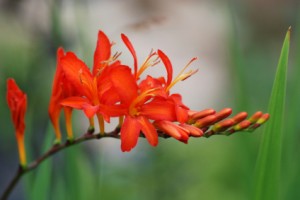Crocosmia
The Crocosmia is a vibrant and rather unusual looking genus in the iridaceae family. It is often referred to as ‘Lucifer’ because they can come in a bright, paprika-like shade of red. In America, they are also known as ‘falling stars’.
Description
Crocosmia are rich orange, tube shaped flowers arranged around a central axis – with little clusters of flowers that branch out into a typical freesia-like flower spike.
There are a number of different variations of the Crocosmia, all of which are amongst the most colourful flowers you can grow. The Crocosmia Babylon, Zambezii, Constance and Saracen all reach heights of around 70cm in the summer and autumn months, with the Lucifer often exceeding 90cm.
Habitat
Crocosmia originated in South Africa but they have been cultivated all around the world. You can also find them in more moderate climes such as the United Kingdom, even in the winter.
Availability
This flower blossoms throughout the summer and is caught at its best in July and August, but it can survive right through the winter.
Species
Crocosmia have around 13 different species, as well as 3 other hybrids, including the crocosmoides and crocosmiiflora. The American ‘falling stars’ naming refers to the crocosmia aurea.
Care Tips
They are relatively easy to grow and are quite hardy, so they are manageable in a variety of climates. They do, of course, survive best with full exposure to the sun and partial shade now and again. It is recommended that you cut the end of the stems at an angle and place them in lukewarm water, containing cut flower food, to prolong their life.
Did you know?
- Crocosmia used to be known as Montbretia, but this is no longer considered to be its correct name. The name ‘Crocosmia’ comes from the Latin ‘croceus’, which means ‘saffron-coloured’.
- They don’t always require an abundance of high quality soil to grow properly – they are known to grow in rocky patches in wild areas of Africa.



